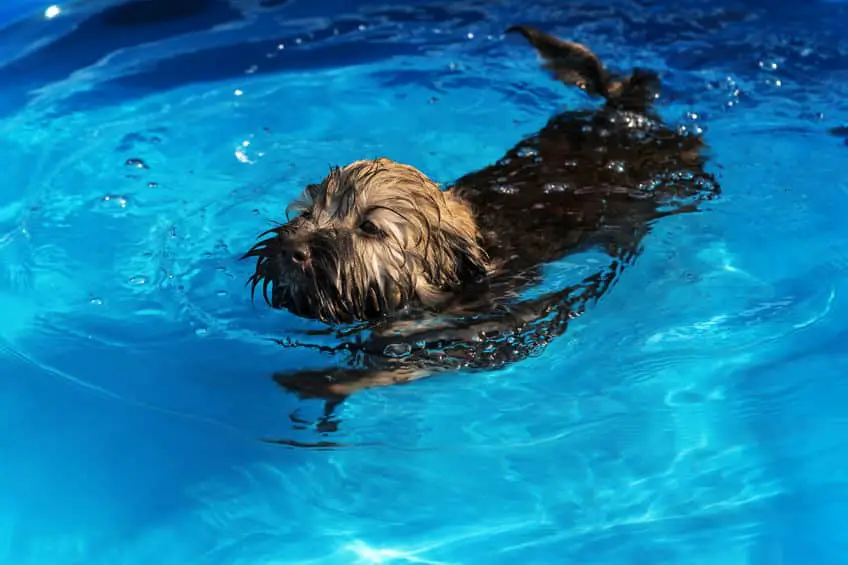The Havanese packs more endurance than its petite cuteness lets on. You can create a fitness regimen specifically to cater to it, or you can have it accompany you to yours. Either way, with the right conditions, this adorable breed will keep up.
On land or in water, you will need to be delicate and patient, and you will be rewarded. The Havanese is an easy dog to train because it is instinctive to please their families. They adapt easily to change, and that should make your lessons very fun.
Their endurance and energy levels are medium and their daily exercise time capped at 60 minutes and able to do up to 7 miles (11 km) of hikes and walks.
In this blog post, we will take a look at various physical activities you can do with your Havanese, from going swimming to taking a walk, hike or going for a jog.
Let’s get started.
Can Havanese Dogs Swim?
Yes, Havanese dogs like most dogs can swim and if properly taught can make very good swimmers.
Unlike dogs like the Golden and Labrador Retrievers, most dogs, Including your Havanese, will most likely struggle on their first attempt at swimming.
Your Havanese’s first attempts shouldn’t lead to a conclusion that they are incapable, especially if it doesn’t go as planned.

Here are a few tips to consider before you get your Havanese in water.
1) Don’t wait until your Havanese’s first experience is an emergency. With this in mind, you’ll be more driven to get them to learn. Remember that they will be eager to please you and it will be easier than with most breeds.
2) Ensure your Havanese’s hair is trimmed to a short coat, as chlorine in pools will dry up their hair. A long coat will not be as silky after a dip in the pool and caution is necessary.
3) Ensure good overall health before you start your lessons. Remember that your pet should ideally be at least a year old before you introduce your lessons.
How to teach your Havanese to swim
After you have ensured that your pet is ready to start lessons, here’s how to get your Havanese splashing around like a pro
1. Ensure your Havanese ALWAYS has a safety vest on. You can order one online, and ensure it’s a good fit.
2. Instill in your Havanese to always wait for a signal, before getting into the water. This will prevent unnecessary accidents on the Havanese’s part.
3. Always give your Havanese between half an hour to an hour after their meal or drink to start your lesson.
4. Use lots of praise and treats as Havanese are very emotional dogs. They want to be seen to be pleasing, and the more they are praised, the easier the lessons will be for you both. As a precaution, serve the treats AFTER the lesson on dry land.
5. Keep them on a leash during other water visits and secure any pool you own or can access with locks and where possible, install a pool alarm in case they venture off on their own.
6. For your Havanese’s safety, sign up for an animal CPR class. This will embolden you to know that you will be able to handle any emergencies that may come up if anything goes south.
Always remember to use positive reinforcement for the best results, as a Havanese dog will only progress under them. Rewards may range from actual snacks to rubs, verbal praise, increased playtime, and individual treats your Havanese prefers.
Can I go walking/jogging with my Havanese?
Yes, you can take your Havenese on long walks and jogs.
Statistics from the leading breeders of Havanese dogs read that they are listed as dogs with some of the longest life spans; up to 16 years. An active lifestyle will contribute greatly to your pet hitting those targets, and have more time to spend together.
An adult Havanese dog weighs about 13 pounds (5.9 kg), and you will need to talk to your veterinarian to ensure your pet doesn’t gain or lose too much weight during your fitness regimen.
Remember that:
1. An overweight Havanese stands to suffer from more health issues.
2. It is easier to regulate the recommended weight than to attempt to shed it.
3. Too much exercise will negatively impact your dog, just as neglecting their health will
Things to consider when taking your Havanese on a run
Most walkers, already know that their pet Havanese can keep up. For joggers and runners, you and your pooch can join in the fun, provided you always cross-check the list below:
1. Ensure you aren’t always outrunning your Havanese
For all their energy, you might find that you might wear them out in their pursuit to keep up with you. They do love to run and be by your side, so you must always ensure that they get their healthy dose of exercise within healthy parameters.
2. Ensure that your Havanese is not out of breath
Just like humans, you can check out your dog’s fitness by the rate at which they are breathing. Shallow breaths to indicate a normal pace, and deep breaths to indicate a struggling Havanese. Remember to slow down if your pet is showing signs of heavy breathing.
3. Take your time
Remember to keep your runs short initially, until your Havanese can keep up. Contain the thrill to get the wind in your hair with your hair in tow, as your Havanese needs to gradually grow its lung and endurance capacity.
4. Don’t test the limits of your Havanese
After you know your pet’s capability, don’t keep your pet at that peak pace. This is a fun activity and should remain as such. If your pet is capable of a 40-minute run, then keep it at 30 minutes and walk off the rest of the distance, which is roughly 70% of their capacity.
5. Hydrate.
Ensure your Havanese has had enough water to sustain the workout you will subject it to. It is healthy to regulate its water intake, in line with the distance and the intensity at which you are running. Rain or shine.
Havanese despite their outward appearance, are tough dogs that can withstand hikes of up to 5 miles (8 km) if the conditions allow. Arrange for a grooming session after, both as a reward, and to keep their hair silky and clean.
Health concerns associated with Havanese
In as much as we would like to get up and active, taking our pooch with us in our various fun activities and exercises, we must take into account the various health concerns associated with our pooch, which in this case is the Havanese.
Below are some health concerns you should be aware of as regards to the Havanese:
Hip dysplasia
Your Havanese’s hips and elbows are at risk of an inherited disease that leads to the joints developing improperly and resulting in arthritis. Hardness in your Havanese’s elbows or hips may burden them as they grow. An overweight pet develops these problems earlier, so exercise will help!
Eye concerns
Cataracts lead to blindness in aging Havanese. Their eye lenses become clouded, and not clear as they should be on the examination. If this doesn’t improve naturally, surgery can rectify this issue
Skin Conditions
Taking care of your Havanese’s skin after a swim or a walk is very important, as they are prone to multiple skin issues. You may see dry, scaly skin with patches of hair loss on the top of his face, his back, and his neck.
Shampoos and supplements can take care of this once detected early.
Heart disease
If your dog has a heart murmur or outward signs suggesting heart problems, It is necessary to perform testing to determine the severity of the disease. The same tests will need to be repeated at least every year to monitor the condition.
Veterinary dental care and fatty acid supplementation can help prevent heart disease and weight control can help diminish symptoms.
Knee Problems
Occasionally, your Havanese’s kneecap might slip out of place. Not to worry, your pet will usually kick out their leg sideways and pop the kneecap back in place. In severe cases, surgery may be needed to realign the kneecap to keep it from popping out of place.
Improving your Havanese’s health and well-being
Build his/her routine care into your schedule to help your Havanese live longer, stay healthier, and be happier during his/her lifetime. We cannot overemphasize the importance of a proper diet and exercise routine.
Other tips includes:
1. Supervise your pet as you would a toddler. Keep doors closed, pick up after yourself, and block off rooms as necessary. This will keep her out of trouble and away from objects they shouldn’t put in their mouth.
2. Daily brushing and regular trimming is recommended to prevent mats and keep their long coat beautiful.
3. Havanese generally have good teeth, and you can keep them perfect by brushing them at least twice a week!
4. Clean their ears weekly, even as a puppy. Don’t worry—we’ll show you how!
5. They are well suited for apartment living; they will need daily walks and regular inside play.
6. They are highly intelligent and can be taught to perform a variety of tricks to keep them mentally stimulated.
7. Keep your dog’s diet consistent and don’t give them a lot of cooked human food as some food can be toxic and dangerous to them. Check out this comprehensive list of foods dogs CAN and CANNOT eat.
8. Feed a high-quality diet appropriate for their age.
9. Exercise your dog regularly, but don’t overdo it in the beginning.
Conclusion
The more in shape your Havanese is, the longer its life span, and the more trips, runs, and memories you can create together.
It is possible to train your Havanese to swim. Ensure conditions are ideal and also have patience and approach your sessions as fun, bonding time.
Engage a veterinarian to offer dietary and physiological advice, to maximize the benefits your Havanese will get from the new forms of exercise.
Your Havanese is a social breed, ensure you don’t leave your pet unattended or home alone for extended periods.

